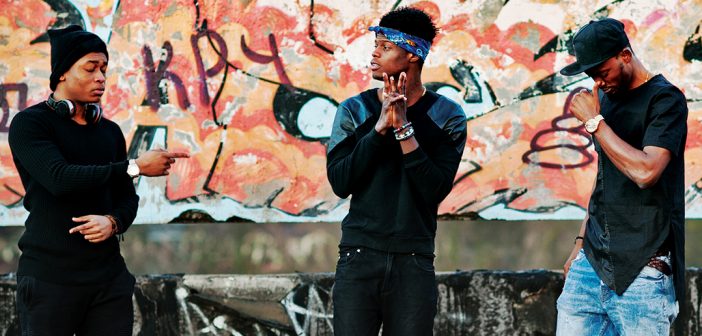Culture-Music:
The new crop of rappers provoking a change in the industry
Independence has always been a reality for the Brazilian rap scene, which has managed to reach its public without the support of any mainstream media or recording industry. One of scene’s leading acts, Racionais MC’s, managed to sell over one million copies of his album Sobrevivendo no Inferno (Surviving in Hell) completely independently.
The social changes of the last decade have affected almost all areas of Brazilian rap, from the shifts in marketing dynamics to the new forms of management and organisation. And just like the pioneers who influenced a generation, a new crop of rappers is provoking even further change in the industry.
Influenced by the success of companies like Emicida’s Laboratório Fantasma, Cone Crew Diretoria’s Coffeshop ConeCrew, or the VVARorganization, old school rappers such as Racionais MC’s and Dexter (ex-509E) have established their own agencies to control their copyrights, sell merchandise and tickets, as well as taking on new artists in a management capacity.
Increased access to technology and working capital in the suburbs, as well as the relative decline in the conventional model of music production that was previously dominated by the major labels, have all created favourable conditions for the genre, akin to that of the American rap scene in the 1990s, typified by the emergence of labels like Death Row, No Limit and Roc-A-Fella.
In addition, the new MPB – Música Periférica Brasileira, as ex-SNJ member Sombra calls it – has carved open a new niche in the space left open by the stagnation of other genres such as rock and traditional MPB, which remain dominated by aging artists who shot to fame between the 1970s and 1990’s.
The hip hop movement, together with break dancing and graffiti, arrived in Brazil (principally in São Paulo) in the 1980s, just a few years after the craze gripped the US. It gained popularity thanks to local DJs and the record stores at the Rock Gallery in the city centre, an area that was initially shared with the existing punk movement of the day, before moving on to the São Bento metro station where break dancers and rappers could practice their skills.
The first true recordings of Brazilian rap were released in 1988 on the compilation Hip Hop Cultura de Rua (1988, Eldorado). It featured tracks by Thaíde & DJ Hum (produced by Nasi and André Jung, of the rock group Ira!), MC Jack, Código 13, amongst others. It is worth noting that there had been some previous attempts to incorporate rap music in Brazil – such as the hit Kátia Flávia, recorded by Fausto Fawcett and Robôs Efêmeros. Scratching had also been used in 1987 by the São Paulo band Gueto on their album Estação Primeira.
In 1988, the Zimbabwe label released a compilation entitled Consciência Black, which featured two tracks by Racionais MCs – Pânico na Zona Sul and Tempos Difíceis. By the beginning of the 1990s, Thaíde & DJ Hum and the Racionais were recognised as the most important and serious names of the São Paulo rap movement, regularly involved in social projects that helped promote the hip hop culture in Brazil.
At the same time in Rio de Janeiro, Gabriel Contino, known as Gabriel Pensador, released his 1992 hit song Tô Feliz, Matei o Presidente (I´m Happy, I Killed the President), written about Fernando Collor, who had just renounced his presidency in the face of imminent impeachment for corruption. This was followed by Lôraburra and Retrato de um Playboy, which, although with heavy pop leanings, featured strong lyrics that criticised certain aspects of local Rio culture.
At the same time rap was spreading to the rest of Brazil with artists like Câmbio Negro and GOG (Brasília), Faces do Subúrbio, Chico Science and Sistema X (Recife), Da Guedz and Piá (Porto Alegre) and Black Soul (Belo Horizonte). By the end of the decade, rap was already being fused with rock music by acts like Planet Hemp (with Marcelo D2) and Pavilhão 9.
The peak of the rap movement was the 1998 release of Sobrevivendo no Inferno by Racionais MCs, which features the classic track Diário de um Detento. The success of the album paved the way for the national rap movement, with the major record labels signing most of the established artists by the late 1990s. Marcelo D2 released his first solo album Eu Tiro É Onda (1998) followed by À Procura da Batida Pefeita which mixed rap with samba. In Recife, the band Faces do Subúrbio focused on embolada, a regional version of rap. São Paulo, however, continued to be the main hub for rap production, with the emergence of artists like DMN, De Menos Crime, Z’África Brasil, RZO, Criminal D, Mzuri Sana, 509-E, Somos Nós A Justiça, Detentos do Rap, Pepeu and Sabotage.
In recent years, a new wave of rappers has emerged, from Minas Gerais, Rio de Janeiro, Ceará, Pernambuco, Paraná, Brasília, Bahia, Goiás, Pará, Rio Grande do Norte, Paraíba, all mixing hip hop with other rhythms, genres and sounds. Brazilian rap now embraces jazz, samba, funk, soul, forró, repente, reggae, bossa nova, brega and electronic music. The participation of women, such as Negra Li, Lurdez da Luz, Karol Conká, Lívia Cruz and Flora Matos has opened the door for new protagonists and new ideas.
During the 1980s and 1990s, rap music focused on the deep national inequalities, the violence in the periphery communities and continued racism, but from the turn of the century attention turned to the economic rise of the lower classes, improved access to education and online information, giving rise to new themes and thinking, from artists such as Parteum, Criolo, Rael, Flávio Renegado, Rashid, Don L, Amiri, OQuadro, ConeCrew Diretoria, Rincon Sapiência, Síntese, B, Negão, Emicida..
Laboratório Fantasma, the agency headed by brothers Evandro and Emicida Fióti since 2008, is a fundamental example of how the distribution of wealth and power – concentrated towards the top of the pyramid (both in society and the local music industry) – can reach the periphery and also enable the rap movement to dominate new spaces, developing not only as a means of cultural expression, but as a business model that generates employment and income for young people from the margins of society.
But the aesthetic appearance of Emicida has also been a parting of the waters as far as the contemporary music scene is concerned, a revitalizing force which is being embraced by a generation of artists who need to reinvent themselves In the November 2013 Brazilian edition of Rolling Stone Magazine, members of Racionais MCs’ were photographed in jackets and ties. The image sparked controversy amongst fans, as they began to question whether the group still represented them. Emicida repeated the gesture on his 2013 album cover O Glorioso Retorno de Quem Nunca Esteve Aqui, stating he was dressed for work. He was recently listed as one of the 30 most influential people in the country by Forbes Brasil.
For a country that regards its songwriters as poets and intellectuals, it remains a challenge – however liberating the change may be – for many to accept that a poor black kid from the periphery is the future bloodline to Tom Jobim, Vinicius de Moraes, Chico Buarque and Caetano Veloso.
Emicida has also revolutionised the professional production standards of local rap music (so many great tracks from the past were marred by poor recording techniques), as well as promoting a greater collaboration of performing musicians in production, rather than relying principally on samples. This, to a great extent, has been possible thanks to financial sponsorship from big companies who can use tax incentives to invest in a range of cultural activities. Since the offset Emicida has also prioritised the production of inspirational video clips.
No doubt, some young film director is already penning a script to bring Emicida’s rise to the big screen. In 2007 he was performing to 50 people in a local club in Santo André. By 2009 he had 3 indications for the VMB, the Brazilian Music Video Awards. Since 2011 he has been touring both the USA and Europe, headlining at Womex in 2015.
He is a product of São Paulo’s underground freestyling scene. Emicida made a living selling mixtapes on the street before he tastes fame and fortune.
2015 also saw the release of his second studio album, Sobre Crianças, Quadris, Pesadelos e Lições De Casa.

















